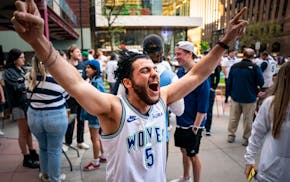The Minneapolis precinct station that burned in the aftermath of George Floyd's murder should never house police again, the City Council declared Thursday.
In a lopsided vote, council members asserted that not only should the charred Third Precinct building in south Minneapolis be eliminated as a possible future precinct headquarters, but the site at the corner of Lake Street and Minnehaha Avenue should never "house any police facility or functions."
"We close this chapter once and for all today," said Council Member Jason Chavez, whose ward borders the location and who sponsored the resolution, which the council approved on a 12-1 vote.
The legal weight of the resolution was unclear. The mayor's office in Minneapolis generally has authority over police matters and where to locate city buildings, while the council has control over how the city spends money.
But the resolution, passed by a veto-proof council majority, effectively stifles any prospect for rebuilding the precinct at the current site — especially since city leaders cast aside that idea earlier in the week.
On Monday, Mayor Jacob Frey endorsed a plan by council President Andrea Jenkins for a medium-term plan to move Third Precinct operations next year to the Century Plaza building, near the Convention Center downtown and well outside the precinct's boundaries. The precinct currently operates from makeshift quarters downtown.
The council unanimously endorsed that plan Tuesday and formally ratified it Thursday in a 13-0 vote.
The pair of council votes Thursday effectively put the nail in the coffin of what had been the city's plan, led by Frey, to choose between two sites for the precinct: the current Lake Street location and a vacant city-owned lot several blocks away.
Chavez is seeking to eliminate the latter location from consideration, though that issue is slated for further discussion in a council committee.
Reactions to those locations were mixed, but one passionate theme emerged from a series of public meetings: Many were unhappy with the entire process, which was set up like a typical site-selection procedure but uncovered the wounds of a community still reeling from the trauma of 2020.
The potential reopening of the vacant Third Precinct building, which is structurally sound but remains boarded and fenced off by razor wire, became a flashpoint.
"Just the thought of it, of returning officers to that building, makes me queasy," Council Member Andrew Johnson said Thursday.
"That building is a symbol. What would be the symbolism of returning MPD officers to that building? It would be returning to the way it was, with a new veneer."
The lone dissenting vote was council Vice President Linea Palmisano, who said she opposed the measure because it would forever ban any future police operations on the site. One day, she said, a building on the site might become a community center offering various government services. The idea that no police officer would be allowed to work in such a space seems overly restrictive, she said.
Still, Palmisano acknowledged, "I realistically am not sure we'll ever move police back into this location."
As for the building itself, many community leaders remain frustrated that there's no plan for it, which Council Member Lisa Goodman decried as "an example of failure."
Council Member Robin Wonsley, whose ward includes the precinct building, said she wants to re-engage the community via a council-led process. She provided no details.

'Minnesota's coming to life': Timberwolves' playoff bid has the fans excited - and ready for more
Tattoo artist inks 'Naz Reid' on dozens of Timberwolves fans ahead of Game 3

